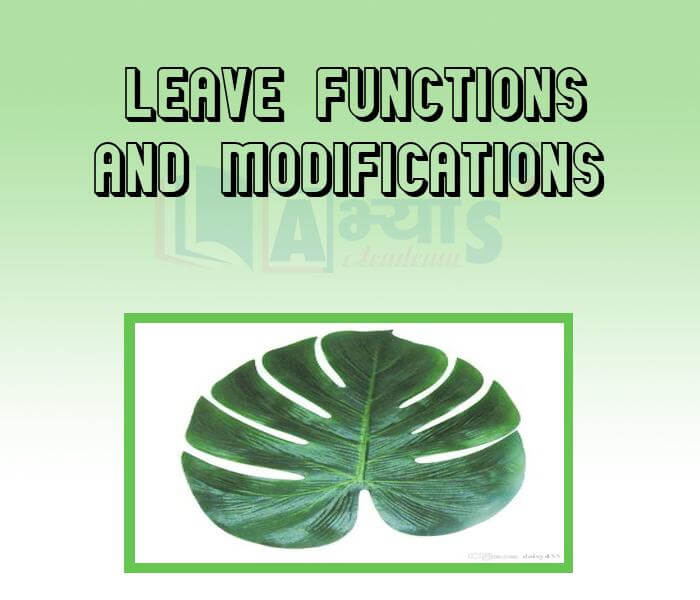Leave Functions and Modifications











Leave Functions and Modifications
Functions of leaf:
This plant food is a kind of simple sugar called glucose. The glucose produced in the process of photosynthesis is utilised by plants for performing various activities. Excess of glucose is stored in the leaf as starch.
Modification of leaf :
Defence : In some plants, such as cactus, date palm and prickly poppy, either the entire leaf or a part of the leaf is modified into spines for defence. These spine prevents the loss of water and protect the plant from grazing animals as well.
Support : In some plants, such as pea, masur and glory lily, the stems are very weak to stand erect. In such palnts leaf or leaflets are modified into leaf tendrils. Leaf tendrils coil themselves around some support and help plants with weak stems to clumb up to expose their leaves to sunlight.
Reproduction : In some plants, such as Bryophyllum and Begonia, buds develop on the leaves. These buds grow a new plants.
Storage of food : In some plants, leaves are modified to store food. The leaves become thick and fleshy.For eg: onion.

The raw material not used by plants for photosynthesis are _______________________- | |||
| Right Option : D | |||
| View Explanation | |||
Which of the following are correct : (a) A leaf prepares food for the plants in the presence of sunlight, carbon dioxide, water, chlorophyll. (b) In some plants, such as Bryophyllum and Begonia, buds develop on the leaves. These buds grow a new plants. (c) The loss of water through the stomata in plants is called transpiration. | |||
| Right Option : D | |||
| View Explanation | |||
Which one of the following is the not the function of leaf ? | |||
| Right Option : A | |||
| View Explanation | |||
Students / Parents Reviews [10]
Abhyas is a complete education Institute. Here extreme care is taken by teacher with the help of regular exam. Extra classes also conducted by the institute, if the student is weak.

Om Umang
10thA marvelous experience with Abhyas. I am glad to share that my ward has achieved more than enough at the Ambala ABHYAS centre. Years have passed on and more and more he has gained. May the centre flourish and develop day by day by the grace of God.

Archit Segal
7thMy experience with Abhyas is very good. I have learnt many things here like vedic maths and reasoning also. Teachers here first take our doubts and then there are assignments to verify our weak points.

Shivam Rana
7thAbhyas Methodology is very good. It is based on according to student and each child manages accordingly to its properly. Methodology has improved the abilities of students to shine them in future.

Manish Kumar
10thI have spent a wonderful time in Abhyas academy. It has made my reasoning more apt, English more stronger and Maths an interesting subject for me. It has given me a habbit of self studying

Yatharthi Sharma
10thAbout Abhyas metholodology the teachers are very nice and hardworking toward students.The Centre Head Mrs Anu Sethi is also a brilliant teacher.Abhyas has taught me how to overcome problems and has always taken my doubts and suppoeted me.

Shreya Shrivastava
8thIt was a good experience with Abhyas Academy. I even faced problems in starting but slowly and steadily overcomed. Especially reasoning classes helped me a lot.

Cheshta
10thIt has a great methodology. Students here can get analysis to their test quickly.We can learn easily through PPTs and the testing methods are good. We know that where we have to practice

Barkha Arora
10thIt was good as the experience because as we had come here we had been improved in a such envirnment created here.Extra is taught which is beneficial for future.

Eshan Arora
8thBeing a parent, I saw my daughter improvement in her studies by seeing a good result in all day to day compititive exam TMO, NSO, IEO etc and as well as studies. I have got a fruitful result from my daughter.
